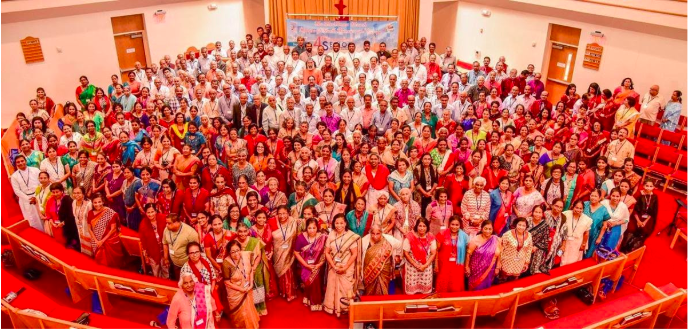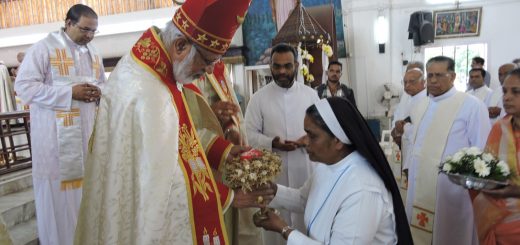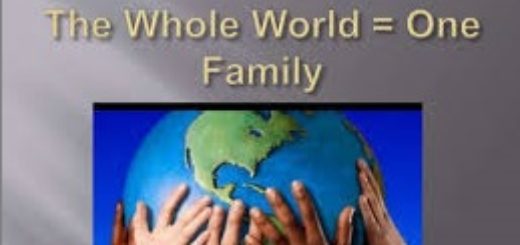Ethnic Indian churches struggle to retain young Indian American Christians within the fold!

“Absolutely essntial reading!”says US sender! By Suman Guha Mozumder, of Dec 10, 2019, sent by our US Rep.& highly qualified journalist in New York
(In the pic: Attendees at the 4th Diocesan Senior Fellowship Conference 2017 hosted by the Mar Thoma Church of Dallas, Farmer’s Branch. (Danny@SD George 5D4)
Note: “I very rarely peg an article as ‘absolutely essential reading,’ but this is one of those rare articles. This article is about youth and Indian churches, especially those from Kerala, in the US.
“Many quoted in the article say they want to go to mainstream churches, rather than the ethnic churches that their parents go to, giving the churches a challenge. It's about the future of Indian churches in the US. It is well researched and reported,” writes the sender.
He happened to be my first Journalism student in Chennai, now in NY as a journalist par-excellence with greater accomplishments than his once master in India with office also at the UN.
Kerala Youth in US
What is more, he is much concerned about the Church in India and in Kerala although he is not a Keralite. The youth of Kerala has always been outspoken, outdoing and out-going; now it seems also leading the outgoing groups, one better than their counter parts in the West!
Can’t believe it? If so read the facts he exposes in what he tersms as ‘absolutely essential reading,’ for Keralites and for the rest of Indian Churches. The fast disappearance of the Indian Ethnic Churches, due to their fast merging with the multicultural English speaking American churches, is the central topic the article discusses.
Augean Stables of Chile!
From January 2019 when Francis visited Chile and exposed its Augian stables, this scribe had been pleading that he should do such a ‘Cleansing of the Temple’ as things are far worse in India due to “Criminal cover-ups and criminal silence of the hierarchical class”. Things are no better even now as ‘skeletons are tumbling down’ with heightened speed from their cupboards.
We wrote ever too many articles in CCV for the last 6 years, of course all fell and continue to fall on deaf ears. Saintly Pope Francis is two years younger to me! At the fag-end of life running 86, I am only too ready and willing to drop out any moment.
Better hands will come up to lead the GOOD FIGHT to guide the Little Flock, who like Jesus will never bend their necks to any insolent Might of the COMFORTABLE CLASS but will stay put like Francis and JESUS, speaking from house tops (Palam Locutus sumj) with the Poor and for the Poor! So rejoice; I say again REJOICE! james kottoor, editor ccv.
Please read the researched article below illustrated with telling visuals of various Churchianities in India!
Next week when tens of thousands of people of Indian descent fill up the pews in churches during Christmas, Josh Koshy, a New York-based young advertising executive will not sit in an ethnic Indian church with fellow Indian Americans but will celebrate the evening at a multicultural church in the city.
Koshy’s family which lives in Dallas are Malayali Christians who belong to the Indian Pentecostal Church, but Koshy, 23, has chosen a different house of worship, Church of the City, as he believes a multicultural church like this provides more diversity and a different theological perspective. And he can relate more to its environment and the current social and other issues in America that come under focus from time to time at his church.
“My parents grew up in India and they did not have to face the issues that I faced in my life in schools and colleges here and obviously they don’t have the same perspective on issues that I can get from a black or a white American. In my church, they can give me different perspectives on issues that are important for me and answer my questions,” Koshy, who moved recently to New York from Colorado, where he grew up, said.
Until a few years ago, people like Koshy who prefer a multicultural church rather than an ethnic house of worship, were only few, as Indian Americans, both young and old, used to go only to an Indian church of their preferred denomination where they would feel at home in the company of their family and friends hailing from the same Indian state and speaking the same language.
But of late that tradition is believed to be somewhat changing, with young, second-generation Indian Americans going to mainstream American churches in preference to an ethnic church their parents have traditionally belonged to and even they themselves had attended in their younger days.
New York-based former U.N. IT official George Abraham, a Malayali Christian who came to the U.S. in the late 1950s when there were hardly any Indian churches in the tristate area, feels the American-born children of Indian parents really don’t feel very attached these days towards their parents’ ethnic churches nor are they drawn to their customs.
Members of the Mar Thoma Church of San Francisco participate in a Christmas Carol Service, Dec. 17, 2018. (Facebook)
“As a matter of fact, some of them think the services in ethnic churches, where the focus is mainly on prayer, is long and boring, and because the proceedings are in Malayalam or other Indian language which they do not quite follow, and tend to leave and go to American churches, many of which are multicultural and have English language services,” Abraham said, adding however, that there are also many young Indian Americans who still follow their parents and go to Indian churches.
Sabu Lukos, vice president of the St. John’s Mar Thoma Church in Long Island, New York, attests to this trend, saying although it is not as yet very strong, the trend is clearly visible. “Once the children leave high school and start going to college, they really don’t enjoy much the activities and services of our ethnic churches,” Lukos said.
Others like Dr. Nehemiah Thomson, a United Methodist pastor who also preaches in Christhava Tamil Koil, a Tamil church in New York City, says many of the second generation Indian Americans do not feel the same kind of attachment to their own congregations like the first generation did and they are not hesitant to go to a mainstream church.
“I won’t say their number is very large at present, nonetheless there is no denying the fact that it is happening more and more across America, although there are also as many young people perhaps who still have allegiance to their traditional ethnic churches of various denominations,” Reverend Thomson, who lives in Somerset, New Jersey, told this correspondent.
Thomson, who was with the Church of South India, the second largest Christian church in India before moving to the U.S. in 1977, and is the secretary of National Association of Asian Indian Christians in USA, says one of the reasons young people go to multicultural and non-denominational churches like the Times Square Church in New York, for example, is the way they talk about God and the modern music and worship which attracts young people.
When Indian Christians immigrated to the U.S., especially those in the late 1950s and early 1960s, they established a few small churches that followed similar liturgical practices like back home. Church services, including gospel readings, were conducted in their native languages for the benefit of the Indian patrons who had limited English proficiency. The interest of their children in the activities of the Indian churches began to somewhat decline, once they grew up in the U.S. and acquired better language skills than their parents.
Although there is no precise estimate about the number of Indian churches of various denominations and independent house of worships, some of the churches having presence in the tristate area include Syro Malabar Catholic Church, Malankara Orthodox Syrian Church, Malankara Jacobite Syrian Church, Mar Thoma Syrian Church, CSI Church, Church of North India and Pentecostal Church.
While the lack of English language service in many of these Indian churches is one of the factors for young peoples’ tendency to slowly leave ethnic churches and join mainstream American church, by no means it is the only one.
One of the reasons young people sometimes feel kind of cut off in Indian ethnic churches is because while youngsters don’t get guidance in ethnic churches that they always look for from their pastors about how to navigate things that are happening around them like the 2015 church shooting in Charleston, South Carolina, activist movements like Black Lives Matter and immigration issues.
“In American churches the pastor is there to give guidance to such issues which are important. Coupled with lack of English language service, this is another factor I believe that contributes to young peoples’ preference for American, multicultural churches,” Carol Kuruvilla, an associate editor of HuffPost Religion, told this correspondent.
Others note that the Indian churches also need to keep in mind that young people love church music and Indian churches need to introduce that element along with regular church service. A New York-based Christian from Kerala, who did not wish to be identified, says while a section of the younger generation is “gravitating towards” multicultural churches, there are still a sizeable portion of the second generation Indian Americans who find home in their traditional churches and make it work for them.
Members of the Telugu Church of Fremont. (Facebook)
“I think people are figuring out what works for them the best. It is not like completely one side or the other. Thus, there are still young Malayali and other people in the Indian churches because they love the community and the native language and culture,” she, told this correspondent.
The Reverend Dennis Abraham, Vicar of the Mar Thoma Church of the San Francisco Bay area, who was born and raised in New York, says his church has been taking note of the concerns of the young people.
The church has introduced English language service for the young church-goers and now there are individual songs with the accompaniment of a small band which are similar to the choir in which people give recitals before the regular service starts in the morning. “And these were not in our churches in the earlier times and have been introduced in response to demands from the younger generation,” Abraham said.
Prema Ann Kurien, professor of Sociology at the Maxwell School of Syracuse University, New York, and author of “Ethnic Church Meets Megachurch: Indian American Christianity in Motion,” noted in an interview titled “Ethnic Christianities” to Sacred Matters magazine last year, that second-generation Mar Thoma Americans had imbibed several of the ideas of American evangelicalism and tended to view a Christian identity as the outcome of achieving a personal relationship with Christ, often beginning with a “born-again” experience.
Language and Culture Of Worship
She said one of the youth in her Mar Thoma congregation liked “the short contemporary service, the music, pastors who are fluent in English, and sermons that are well put-together, and have life application.”
Kurien said another young woman, a second-generation American who had left the Mar Thoma church, was enthusiastic about the large nondenominational church she attended along with her husband. “They have an amazing band, and amazing musicians. And we just love worshiping there. It brings a lot of people from the community in because it’s like a free concert on Sunday morning — bagels and doughnuts too!”
Experts say that the Indian churches have slowly realized that for the younger generation there is not just a language gap there is a cultural gap too and therefore they have now started having services in English called youth services although that is seen as less than sufficient. And that is probably why many youngsters still identify themselves a little bit more with the larger American group and leave the Indian church
Danny @ SD George 5D4
Second generation Indian American Christians and their role in church had come under focus earlier as well. Leema Thomas-Joseph, a digital copy editor with Newsday, wrote in an 2003 article about how the 20-something generation was assuming a greater role in the leadership of Malayali Pentecostal churches, which are working to accommodate the young without alienating the old.
Others point out as a mark of their leadership, more and more second generation Indian American Christians now have embraced priesthood as a full-time vocation. Dennis Abraham, a psychology major from New York, who embraced priesthood as a vocation, is now Vicar of the Mar Thoma Church of the San Francisco Bay area. He says more second generation Indian American Christians from different parts of the U.S. are training in seminaries at present.
“I think we have ten young people right now in my (Mar Thoma) church, but I believe the same trend prevails in some other orthodox churches as well,” Abraham said.
The Syrian Orthodox church is believed to have recruited some 30 such young Indian Christians in the last one decade from the U.S which has traditionally faced shortage of priests and other religious workers. Carol Kuruvilla says there are several Malayalis who are now pastors in American evangelical churches and hold positions in ministries.
A 2008 New York Times report said India, Vietnam and the Philippines are among the leading exporters of priests, according to data compiled by researchers at Catholic University of America in Washington. Although Christians comprise only 2.3 percent of the population in India, according to Pew research they account for 18 percent of the diaspora population in the U.S.With the trend of young Indian American Christians slowly leaning towards multicultural churches, what does the future hold for the traditional ethnic Indian churches in the U.S.?
There does not seem to be one clear answer. People like George Abraham of New York said he fears that someday ethnic Indian churches may meet with the same predicament as those of the once well-established German churches in New York, which gradually went into decline after the Second World War for lack of enough members, including young members, many of whom had moved out of New York city, leading to major change in their composition and eventually making them multiethnic English-language churches.
Lukos, who is from the Mar Thoma denomination, said Indian Americans paid and bought old churches established maybe 100 years ago from Americans who were forced to sell off because they at some point were losing patronage. If young people continue to move out of Indian churches, then it is possible to predict that they will meet the same fate maybe in 60 or 70 years from now.
“That is why we are looking at this issue of youngsters leaving from the perspective of its possible long-term impact on the community and are making all efforts to arrest the trend and save our church,” Lukos said.
Techies and the Old Church
Although she does not have an alarmist view like Lukos, Carol Kuruvilla admits that it is a kind of struggle that is going on in the Indian churches in terms of retaining second generation Indians within its fold and the challenge is to figure out how to keep the young people.
She also argues that for the past decade or so, the H-1B visa under which hundreds of thousands of high-skilled workers from India and their families have been coming to the U.S., has helped in a way to keep the ethnic churches running.
“H-1B visa has really been like a lifeline for the Indian immigrant churches because when the children of the previous generation who formed the churches in the 1980s, grew up and started leaving for colleges and universities and eventually for jobs, the churches had always got new waves of people in the form of folks coming here on guest worker visas who availed of the church services,” she says.
“The H-1B workers and their families have always provided the constant fresh blood into the churches. Now if H-1B visa becomes harder to come by in future, I think that would be a real testing situation for the ethnic Indian churches,” Kuruvilla says.
Irrespective of whether people like Josh Koshy goes to a multi-cultural church or an ethnic Indian church, Indian Americans as a community were gearing up to let their hair down and celebrate the Christmas 2019. Neighborhood caroling had already started.
















